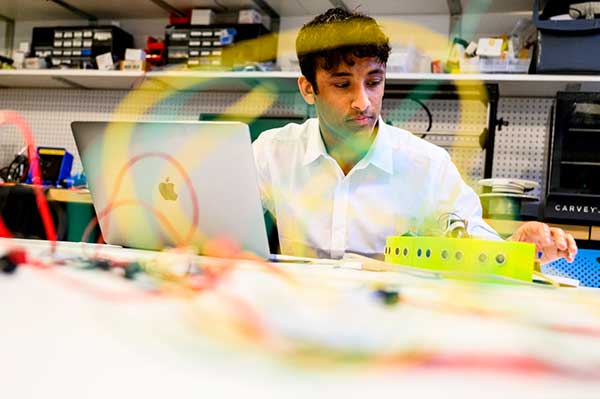Enabling Engineering Students Design Inexpensive Wheelchair Sensor System

Students in Northeastern’s Enabling Engineering class designed a wheelchair rear-sensor system for a resident at The Boston Home, a care center for individuals with progressive neurological conditions. The system met the resident’s needs at a fraction of the cost of a typical wheelchair sensor system.
This article originally appeared on Northeastern Global News. It was published by Cyrus Moulton. Main photo: Hari Narayanam and his team developed a sensor system that alerts a wheelchair user if they are at risk of backing into something. Photo by Matthew Modoono/Northeastern University
Wheelchair sensors can cost $10,000. Here’s how Northeastern engineering students built a better version — for $87
Sarah Connors has multiple sclerosis and limited vision, hearing and mobility. So the hallways, elevator and other residents also using wheelchairs present regular obstacles at The Boston Home where she lives — particularly when they are behind her and she is moving in reverse.
Enter Northeastern University’s Enabling Engineering class and the Haptic Ultrasonic Location Assistant (HULA).
“This system is what best caters to Sarah as our client,” says Alexander Pervizi, a third-year student studying electrical engineering and physics and a member of the team that developed HULA.
 |
 |
 |
 |
 |
Students on the HULA team show off their project. Photos by Matthew Modoono/Northeastern University
The Enabling Engineering class applies engineering to enable and empower individuals with disabilities. Students can select one of several projects focused on addressing the needs of clients who have a disability, and the students present the projects at the end of the semester.
Pervizi, Charles Caiola, Hari Narayanam and Darsh Jha signed up to help Connors.
Connors lives at The Boston Home, a residence and care center for individuals with advanced multiple sclerosis and other progressive neurological conditions. She and her fellow residents use motorized wheelchairs to get around.
But a rear-sensor system for such wheelchairs can cost up to $10,000. Moreover, these sensor systems can require daily calibration and mainly work using visual or auditory signals when they detect an obstacle, students say.
“And for Sarah, it would have to be triple the volume and that would just annoy everybody else,” Caiola says.
A better solution was needed.
HULA is the result.
HULA consists of two main parts — a slightly curved bar that attaches to the rear of the wheelchair and sleeves that go on the wheelchair’s armrests.
The bar at the back of the wheelchair contains ultrasonic sensors. These sensors have a 180-degree radius and can be customized by a click of a switch to detect objects within 8, 10 and 12 inches — distances determined after visiting Connors at The Boston Home and seeing the size of the elevator and the hallways that she and her fellow residents use.
The students discussed Connors’ needs directly with her and The Boston Home staff and adapted the design based on their feedback.
“We actually sat in the wheelchair and went around trying this on, and trying the different ranges,” Narayanam says. “We sort of tried and tested those to make sure that it fit in the different settings they wanted.”
Read full story at Northeastern Global News